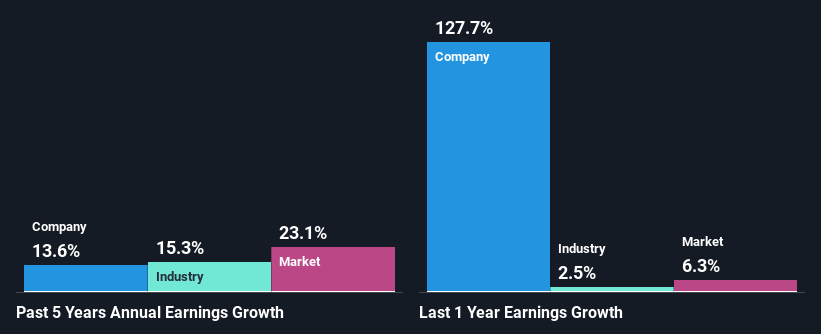Elve S.A. (ATH:ELBE) Stock Is Going Strong But Fundamentals Look Uncertain: What Lies Ahead ?

Elve (ATH:ELBE) has had a great run on the share market with its stock up by a significant 12% over the last week. However, we wonder if the company's inconsistent financials would have any adverse impact on the current share price momentum. Particularly, we will be paying attention to Elve's ROE today.
Return on Equity or ROE is a test of how effectively a company is growing its value and managing investors’ money. In simpler terms, it measures the profitability of a company in relation to shareholder's equity.
Check out our latest analysis for Elve
How To Calculate Return On Equity?
Return on equity can be calculated by using the formula:
Return on Equity = Net Profit (from continuing operations) ÷ Shareholders' Equity
So, based on the above formula, the ROE for Elve is:
9.1% = €1.8m ÷ €20m (Based on the trailing twelve months to June 2023).
The 'return' is the yearly profit. So, this means that for every €1 of its shareholder's investments, the company generates a profit of €0.09.
What Is The Relationship Between ROE And Earnings Growth?
So far, we've learned that ROE is a measure of a company's profitability. Depending on how much of these profits the company reinvests or "retains", and how effectively it does so, we are then able to assess a company’s earnings growth potential. Assuming everything else remains unchanged, the higher the ROE and profit retention, the higher the growth rate of a company compared to companies that don't necessarily bear these characteristics.
A Side By Side comparison of Elve's Earnings Growth And 9.1% ROE
On the face of it, Elve's ROE is not much to talk about. Next, when compared to the average industry ROE of 14%, the company's ROE leaves us feeling even less enthusiastic. Elve was still able to see a decent net income growth of 14% over the past five years. So, there might be other aspects that are positively influencing the company's earnings growth. Such as - high earnings retention or an efficient management in place.
Next, on comparing Elve's net income growth with the industry, we found that the company's reported growth is similar to the industry average growth rate of 15% over the last few years.

Earnings growth is an important metric to consider when valuing a stock. It’s important for an investor to know whether the market has priced in the company's expected earnings growth (or decline). Doing so will help them establish if the stock's future looks promising or ominous. One good indicator of expected earnings growth is the P/E ratio which determines the price the market is willing to pay for a stock based on its earnings prospects. So, you may want to check if Elve is trading on a high P/E or a low P/E, relative to its industry.
Is Elve Using Its Retained Earnings Effectively?
The really high three-year median payout ratio of 109% for Elve suggests that the company is paying its shareholders more than what it is earning. However, this hasn't really hampered its ability to grow as we saw earlier. It would still be worth keeping an eye on that high payout ratio, if for some reason the company runs into problems and business deteriorates. You can see the 2 risks we have identified for Elve by visiting our risks dashboard for free on our platform here.
Additionally, Elve has paid dividends over a period of at least ten years which means that the company is pretty serious about sharing its profits with shareholders.
Conclusion
On the whole, we feel that the performance shown by Elve can be open to many interpretations. While the company has posted impressive earnings growth, its poor ROE and low earnings retention makes us doubtful if that growth could continue, if by any chance the business is faced with any sort of risk. So far, we've only made a quick discussion around the company's earnings growth. You can do your own research on Elve and see how it has performed in the past by looking at this FREE detailed graph of past earnings, revenue and cash flows.
Valuation is complex, but we're here to simplify it.
Discover if Elve might be undervalued or overvalued with our detailed analysis, featuring fair value estimates, potential risks, dividends, insider trades, and its financial condition.
Access Free AnalysisHave feedback on this article? Concerned about the content? Get in touch with us directly. Alternatively, email editorial-team (at) simplywallst.com.
This article by Simply Wall St is general in nature. We provide commentary based on historical data and analyst forecasts only using an unbiased methodology and our articles are not intended to be financial advice. It does not constitute a recommendation to buy or sell any stock, and does not take account of your objectives, or your financial situation. We aim to bring you long-term focused analysis driven by fundamental data. Note that our analysis may not factor in the latest price-sensitive company announcements or qualitative material. Simply Wall St has no position in any stocks mentioned.
About ATSE:ELBE
Elve
Designs, manufactures, and sells ready-made garments in France and internationally.
Flawless balance sheet moderate.


